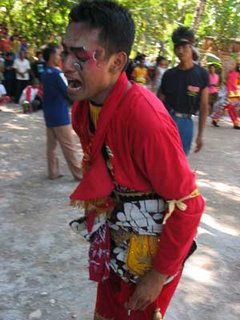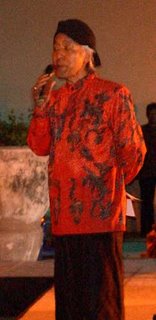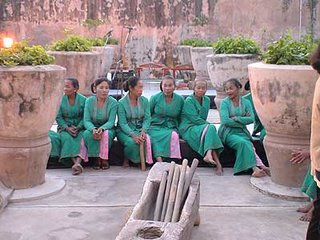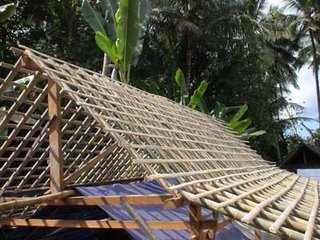Bebekan 12

At the same time we bought the wood, we also bought all the cement and sand needed to clog the cracks of certain houses which are still standing. The cement bags were distributed immediately according to the inventory we previously drew up. We decided not to wait any longer and to provide to the families which already have the new structure-frame, the bamboos and the tiles required to finish the construction of their more-than-rudimentary house in the coming two to three weeks before the arrival of the rainy season. A married couple (friends of Vincent), Nicole (Dutch) and Abott (Indonesian) gave us a very generous gift of 500 bamboos. They themselves, thanks to donations from friends in Holland, have built nearly 200 bamboo houses in a few devastated villages. We still need 1000 more bamboos which we have already ordered and will be delivered to the village on Tuesday September 19. The bamboos are a complement to the coconut-wood carpentry and will support the roof tiles. A TV producer from Yogyakarta, who broadcasts “Nature” programs every morning, came to Bebekan and advised the villagers, in a somewhat learned tone, to build their roof with braided coconut palms. They are light and cheap since they are readily available in the surroundings. But the people of Bebekan do not want to have such roofs because they do not last very long and must be rebuilt every 3 to 5 years. Since they prefer the tiles, we will go along with their decision, knowing that they were able to salvage quite a lot of them. Curiously, the tiles withstood the earthquake much better than the bricks of the walls. In a few days, we will post on the blog the pictures of these first wooden frames.
No international NGO was interested in our project to rebuild these more-than-rudimentary houses. As for the assistance for rebuilding promised by the government, the issue has still not been resolved for any village.
The young people, girls and boys (from 17 to 25 approximately), have expressed the wish to organize a group of Islamic traditional music, known as “Hadroh” or “Hadrohan”, to bring back some life to the mosque which the children have deserted since the earthquake. More than two months ago, a fundamentalist Islamic political party, the PKS, had installed a tent close to the mosque and made an inexpensive swing for the children out of two bamboos and a rope. On the swing, they hooked the flag of their party. The women of this party, completely dressed in black, tried to attract the children inside the mosque for classes in Koranic reading, but they didn't have much success. The initiative of the young people of Bebekan of reappropriate their mosque with sufi music is thus more than welcome. We will help them buy the percussion instruments known as “rebana”. The “Hadroh” was born in the Javanese Koranic schools of the XIXth century. It is a music primarily made of captivating percussions to accompany songs, prayers and praises in Arabic or Javanese, and it is played by women and men together. “Hadroh”, a word derived from Arabic, means “to present oneself”, to present oneself in front of God. We thus met Thursday evening of last week under the veranda of the mosque with the young people of Bebekan and some of their friends from a neighboring village which has already organized a group of Hadroh. Their friends arrived with their instruments to teach them the basics. Some of the young people in the Hadroh group are also members of the Reog group. It is quite amazing to have seen them go in a trance a few days ago and then to see them again so concentrated and focused, impeccably dressed in a sarong and a black cap.

I had promised to write a text about the Reog trance, but I haven't yet found the time to do so. Here are some basic concepts. There are two types of trance : the satanic trance, which is the Reog one, where the dancers summon spirits which they themselves call “Satans”, and then the divine trance, the intoxication of the sufis. It seems that in Bebekan the villagers can live the two types of trance without conflict. The first one is frowned upon and therefore prohibited by many Moslems, even very liberal ones, because they say it brings in Satan in man. But after weeks of observing the Reog rehearsals in Bebekan, I wonder whether it is not the opposite which is true : in the trance, it is the devils that we all harbor in ourselves (anger, hatred, jealousy, fear…) who are thrown out, and the dancers, gradually, from dance to dance, are freed from them. They themselves raise the question, since the elders find that the young people enter in a trance too quickly and too easily. “When we were young, one of them said during a discussion after a Reog rehearsal, we waited until the battle scene was finished to go in a trance. Today, the young people do it after a mere 10 minutes. Even the musicians go in a trance.” Who are these spirits which come inside the dancers? On August 19, at the end of a Reog performance in Bebekan, within the framework of the Independence Day festivities, one of the young dancers was still possessed. During the rehearsal, he had gone out of the “arena” in a trance, a gesture which is considered dangerous and is thus prohibited. Trance is authorized and supported within a very precise time and space framework. It is only with great difficulty that the villagers were able to capture him after he had “escaped”. After the performance, he was still in an acute trance state. Many adults surrounded him and tried to release him and to calm him down, but it was impossible. Then a young man arrived from a neighboring village and asked for a glass of water. He made the dancer drink the water, and then had him spit it out back in the glass; he also did the same, after which he rapidly capped the glass with his hand, ran at the top of the hill towards the cemetery and threw out among the tombs the captive spirit in the glass. He then told us that this spirit was “the first ancestor of Bebekan”. This young man is known to be able to speak with the ancestral spirits. And this evening, under the veranda of the mosque, he is a member of the group of friends from the neighboring village who come here to teach to the young people of the village the “Hadroh” sufi music, which leads to divine intoxication.
The Reog group in its current form was really born with the new generation, just a few days after the earthquake. In the evenings, the young people were beating out on jerry cans or bamboos the rhythms that their elders played before the earthquake. After the disaster, the elders decided to withdraw, to leave the place to these young people and to become their coaches. I wonder if the fact that these young people can so easily and readily enter in a trance is not related to the earthquake : their material world being completely destroyed, didn't they have the vital need to connect with the spiritual world of their ancestors, this invisible chain which can enable them to be rebuilt physically, to find their material landmarks? I felt they were impelled by the urge to connect to this memory of space and time of the village of Bebekan, a memory immortalized in the spirit of their ancestors whom they call in them by the trance. Monday September 11. I have received an email from a very dear friend of mine, Alex Dea, a Chinese-American ethnomusicologist, computer specialist and composer, who has lived in Java for 25 years. One of his friends, Leonard, has just published a very beautiful book full of magnificent photos and brilliant texts on Yogyakarta and will launch the book in Taman Sari, the old water-baths of the sultans. These baths, a mixture of Javanese, Chinese and Portuguese architecture, were restored last year with the assistance of the Portuguese government and became the smartest place in town to organize cultural events or fashion parades. There is an underground mosque and a row of courtyards, basins and turrets. It is a magical place and highly charged with history, sexuality and spirituality. To animate the launching of the book, Alex had a generous and brilliant idea: rather than inviting some pop stars to perform a “charity concert” in order to collect funds for the “poor victims of the earthquake”, he proposed to inverse the process : to invite precisely the artists-victims of the earthquake to perform on the stage of Taman Sari. Two groups were invited. The first one is a group of country-women which the great Javanese dancer, Didik Nini Thowok, has been training for several years. They come from the village of Pundong (south of Yogyakarta) which was completely destroyed by the earthquake. They perform fertility dances, known as “Gejok Lesung”, to the rhythms of a single musical instrument : a large wooden rice-mortar struck by big wooden pestles to accompany the singing of the women. The second group was the Reog of Bebekan which is called: “Satria Muda Budaya” (Young Knights of Culture). They only had four days to prepare a condensed 20 minute version of their performance on the complex stage built upon the various pools and basins of Taman Sari. Asep and I went there at dusk to draw the exact plan and the precise dimensions of that special stage. Then we drove to Bebekan. The Reog elders, who are now training the young people, at once used chalk to draw on the floor of a collapsed house the full scale and exact shape of that stage. The dancers rehearsed during the night inside that fictive space. On the only wall still standing and covered with sad graffiti (written on the very same day of the earthquake : “What will we eat tomorrow? ” “My house is destroyed, my heart weeps”), they hung a large clock in the shape of a mosque, as a sort of stop watch, to monitor the time and not exceed the 20 minutes allotted to their performance.
Monday September 11. I have received an email from a very dear friend of mine, Alex Dea, a Chinese-American ethnomusicologist, computer specialist and composer, who has lived in Java for 25 years. One of his friends, Leonard, has just published a very beautiful book full of magnificent photos and brilliant texts on Yogyakarta and will launch the book in Taman Sari, the old water-baths of the sultans. These baths, a mixture of Javanese, Chinese and Portuguese architecture, were restored last year with the assistance of the Portuguese government and became the smartest place in town to organize cultural events or fashion parades. There is an underground mosque and a row of courtyards, basins and turrets. It is a magical place and highly charged with history, sexuality and spirituality. To animate the launching of the book, Alex had a generous and brilliant idea: rather than inviting some pop stars to perform a “charity concert” in order to collect funds for the “poor victims of the earthquake”, he proposed to inverse the process : to invite precisely the artists-victims of the earthquake to perform on the stage of Taman Sari. Two groups were invited. The first one is a group of country-women which the great Javanese dancer, Didik Nini Thowok, has been training for several years. They come from the village of Pundong (south of Yogyakarta) which was completely destroyed by the earthquake. They perform fertility dances, known as “Gejok Lesung”, to the rhythms of a single musical instrument : a large wooden rice-mortar struck by big wooden pestles to accompany the singing of the women. The second group was the Reog of Bebekan which is called: “Satria Muda Budaya” (Young Knights of Culture). They only had four days to prepare a condensed 20 minute version of their performance on the complex stage built upon the various pools and basins of Taman Sari. Asep and I went there at dusk to draw the exact plan and the precise dimensions of that special stage. Then we drove to Bebekan. The Reog elders, who are now training the young people, at once used chalk to draw on the floor of a collapsed house the full scale and exact shape of that stage. The dancers rehearsed during the night inside that fictive space. On the only wall still standing and covered with sad graffiti (written on the very same day of the earthquake : “What will we eat tomorrow? ” “My house is destroyed, my heart weeps”), they hung a large clock in the shape of a mosque, as a sort of stop watch, to monitor the time and not exceed the 20 minutes allotted to their performance.
On the evening of Friday, September 15, the Young Knights of Culture arrived at  Taman Sari by bus in their most beautiful costumes. It was undoubtedly the classiest evening which Yogyakarta has seen in these last months : among the guests were the brothers and the youngest daughter of the sultan, the greatest designers of the city and plenty of Australian wine… One of the Reog elders, who only has one arm (the other was crushed in a machine to sort soya beans), brought resin of benzoin (a traditional Javanese incense) and petals of red and white roses as offerings to the spirit of the place and to ask for the “authorization” to dance the Reog of Bebekan that evening in these old royal baths.
Taman Sari by bus in their most beautiful costumes. It was undoubtedly the classiest evening which Yogyakarta has seen in these last months : among the guests were the brothers and the youngest daughter of the sultan, the greatest designers of the city and plenty of Australian wine… One of the Reog elders, who only has one arm (the other was crushed in a machine to sort soya beans), brought resin of benzoin (a traditional Javanese incense) and petals of red and white roses as offerings to the spirit of the place and to ask for the “authorization” to dance the Reog of Bebekan that evening in these old royal baths.
Thank you to all of you who have contributed to transform, for one evening, the nightmare of the earthquake into a fairy tale.

